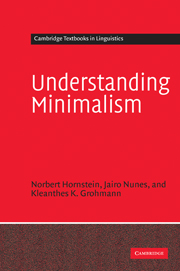Book contents
- Frontmatter
- Contents
- Preface
- List of abbreviations
- 1 The minimalist project
- 2 Some architectural issues in a minimalist setting
- 3 Theta domains
- 4 Case domains
- 5 Movement and minimality effects
- 6 Phrase structure
- 7 Linearization
- 8 Binding Theory
- 9 Feature interpretability and feature checking
- 10 Derivational economy
- Glossary of minimalist definitions
- References
- Language index
- Name index
- Subject index
9 - Feature interpretability and feature checking
Published online by Cambridge University Press: 05 June 2012
- Frontmatter
- Contents
- Preface
- List of abbreviations
- 1 The minimalist project
- 2 Some architectural issues in a minimalist setting
- 3 Theta domains
- 4 Case domains
- 5 Movement and minimality effects
- 6 Phrase structure
- 7 Linearization
- 8 Binding Theory
- 9 Feature interpretability and feature checking
- 10 Derivational economy
- Glossary of minimalist definitions
- References
- Language index
- Name index
- Subject index
Summary
Introduction
This chapter focuses on the checking procedure that has been relied upon thus far, and on the traditional distinction between overt and covert movement. We'll take the analyses developed in previous chapters as a starting point, discussing their consistency with the general architectural features of the model and raising further minimalist questions.
Section 9.2 reviews aspects of checking theory and throws up a number of major questions; we will examine each of these questions in the sections that follow. In section 9.3 we discuss the hypothesis that feature checking is actually triggered by the need to eliminate [−interpretable] features from the computation. section 9.4 examines two reanalyses of covert movement that are compatible with the Uniformity Condition: the Move-F and the Agree approaches. Finally, section 9.5 concludes the chapter.
Some questions concerning checking theory
Let's first review the initial motivation for the introduction of checking within the system. As seen in section 2.3.1.1, the standard view within GB that Case Theory should apply at SS rests upon two technical assumptions: first, that Case is assigned and second, that such assignment takes place under a government configuration. We've shown that an equally plausible implementation of Case Theory could cover the core set of Case-related phenomena without resorting to SS as a level of representation. Specifically, nominal elements could enter the derivation with their Case-features already specified, and the appropriateness of a particular Case-bearing element in a given structure would be enforced by a checking procedure matching such Case-feature with the Case-feature of a local head.
- Type
- Chapter
- Information
- Understanding Minimalism , pp. 286 - 329Publisher: Cambridge University PressPrint publication year: 2005



